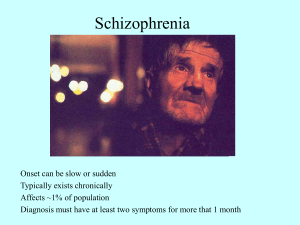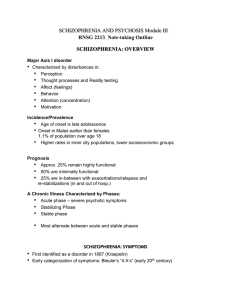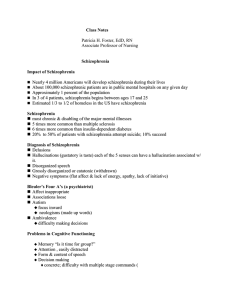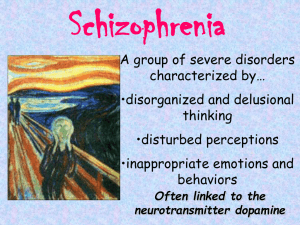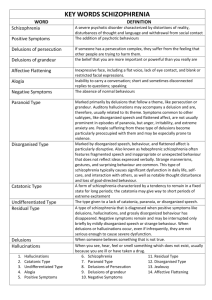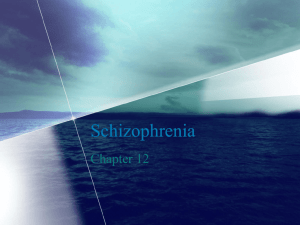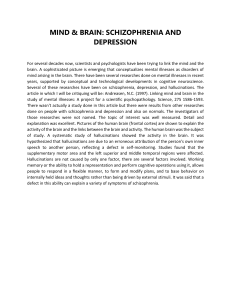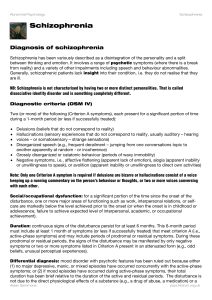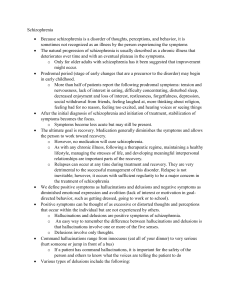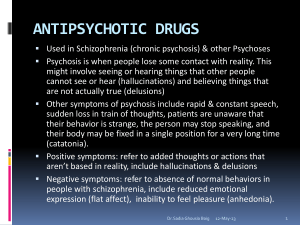Chapter 12 - Schizophrenia
advertisement
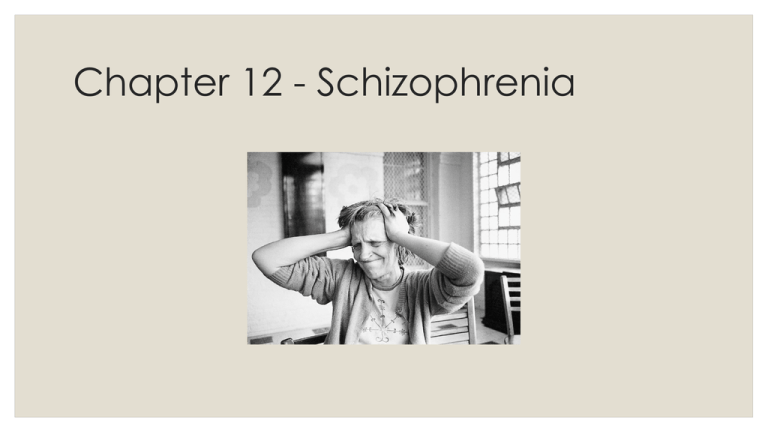
Chapter 12 - Schizophrenia Psychosis Psychosis: a loss of contact with reality Ability to perceive and respond to the environment significantly disturbed; functioning impaired Symptoms may include hallucinations (false sensory perceptions) and/or delusions (false beliefs) Schizophrenia ◦ Individuals must show a deterioration in their work, social relations, and ability to care for themselves ◦ Six months or more Schizophrenia ◦ Affects approximately 1 in 100 people in the world ◦ Financial & emotional costs: enormous ◦ Increased risk of suicide and physical – often fatal – illness Schizophrenia appears in all socioeconomic groups, but is found more frequently in the lower levels “downward drift” Schizophrenia average age of onset for ♂ is 23 years, compared to 27 years for ♀; book states = numbers; other sources ♂ > ♀ Rates of diagnosis differ by marital status The Clinical Picture ◦ symptoms, triggers, and course vary greatly ◦ Some argue: group of distinct disorders that share common features Positive Symptoms Pathological excesses bizarre additions to a person’s behavior •Excess or distortion in normal repertoire of behavior and experience Delusions • Erroneous belief • Fixed and firmly held despite clear contradictory evidence • Disturbance in the content of thought • Grandeur • Persecution • Reference • Nihilistic • Thought Broadcasting Delusions Hallucinations • False Sensory experiences/Perceptual disturbances • Seems real but occurs in absence of any external perceptual stimulus • Can occur in any sensory modality Hallucinations Disorganized Speech • Failure to make sense • Despite conforming to semantic and syntactic rules of speech • Disturbance in form (not content) of thought Disorganized speech Disorganized Behavior • Impairment of goaldirected activity • Occurs in areas of daily functioning • Catatonia • Catatonia stupor • Inappropriate affect Disorganized and Catatonic Behavior Negative Symptoms Absence or deficit of normally present behaviors • Affective flattening, Blunted affect • Anhedonia • Apathy • Both a symptom and coping strategy • Avolition • Alogia Neurocognition Neurocognitive deficits found in people with schizophrenia Attentional and working memory deficits Eye-tracking dysfunctions Course usually first appears between late teens and mid-30s three phases: Prodromal Active Residual DIATHESIS STRESS MODEL: A Synthesis Multiple genetic factors Environmental factors Current thinking emphasizes interplay CAUSES TWIN STUDIES The average concordance rate for MZ twins is 48%, whereas the comparable figure for DZ twins is 17%. Suggests strong genetic factors. Also compelling evidence for the importance of environment. Genain quadruplets ADOPTION STUDIES ◦ Genetic factors play role in development of the disorder (Heston). Biological Views Biological Views Genetic factors may lead to the development of schizophrenia through two kinds of (potentially inherited) biological abnormalities: ◦ Biochemical abnormalities ◦ Abnormal brain structure BIOLOGICAL CAUSES The dopamine hypothesis Interactions of multiple neurotransmitters ◦ Focuses on the function of dopamine in the limbic area of the brain. ◦ Current research focuses many neurotransmitters: ◦ Dopamine ◦ Serotonin ◦ Glutamate ◦ Hypothesis grew out of attempts to understand how antipsychotic drugs improve adjustment. Prenatal Exposures Prenatal exposures: Prenatal viral infection Early nutritional deficiencies and maternal stress Pregnancy and birth complications Cytoarchitecture •Overall organization of cells in brain may be compromised Biological Views Abnormal brain structure enlarged ventricles enlargement may be a sign of poor development or damage in related brain regions smaller temporal and frontal lobes, smaller amounts of grey matter, and abnormal blood flow to certain brain areas Sociocultural Views Social labeling Many sociocultural theorists believe that the features influenced by diagnosis itself Society labels people who fail to conform to certain norms of behavior Once assigned, label becomes a self-fulfilling prophecy The dangers of social labeling have been well demonstrated Example: Rosenhan’s 1973 “pseudo-patient” study Sociocultural Views Family dysfunctioning often linked to family stress: Parents of people with the disorder often: Display more conflict Have greater difficulty communicating Are more critical of and overinvolved Family theorists have long recognized that some families are high in “expressed emotion” – family members frequently express criticism and hostility and intrude on each other’s privacy Individuals who are trying to recover almost four times more likely to relapse if they live with such a family Treatment: Antipsychotic Drugs ◦ the discovery of antipsychotic drugs in 1950s that revolutionized treatment for those suffering from schizophrenia ◦ Have a relatively specific effectreduce psychotic symptoms ◦ Work as dopamine antagonist ◦ Positive symptoms respond better than negative symptoms. reduce symptoms in at least 65% of patients Motor Side Effects (parkinsonian symptoms) ○Extrapyramidal symptoms ○Tardive dyskinesia Second-Generation Antipsychotics ○ Atypical antipsychotics ○ Work on both serotonin and dopamine ○ Impact both positive and negative symptoms ○ Examples: Clozaril, Risperdal, Zyprexa, Seroquel, Geodon, and Abilify Newer Antipsychotic Drugs appear more effective than conventional antipsychotic drugs, especially for negative symptoms cause few extrapyramidal side effects and seem less likely to case tardive dyskinesia Some, however, do produce significant undesirable effects of their own Cognitive-behavioral therapy Clinicians employ techniques that seek to change how individuals view and react to their hallucinatory experiences, including: Provide education and evidence of the biological causes of hallucinations Challenge clients’ inaccurate ideas about the power of their hallucinations and delusions Family therapy ◦ Over 50% of persons recovering from schizophrenia and other severe disorder live with family members ◦ This creates significant family stress ◦ Those who live with relatives who display high levels of expressed emotion are at greater risk for relapse than those who live with more positive or supportive families Family therapy ◦ Family therapy ◦ Family therapy attempts to create more realistic expectations and provide psychoeducation about the disorder Social Therapy Treatment should include techniques that address social and personal difficulties include: practical advice, problem solving, decision making, social skills training, medication management, employment counseling, financial assistance, and housing
